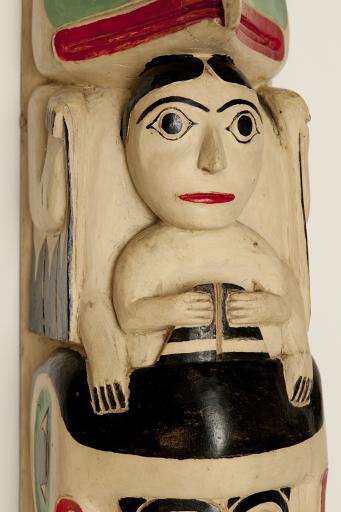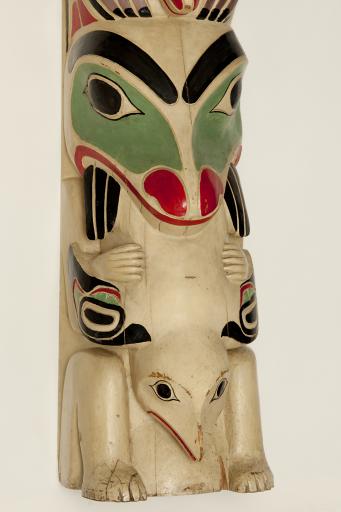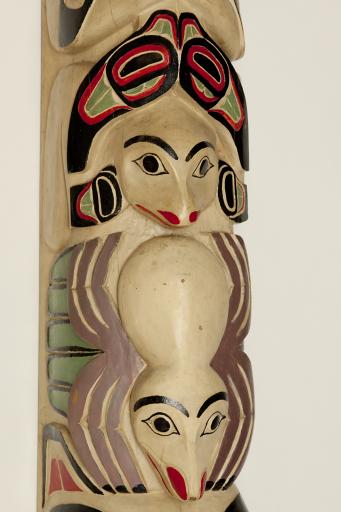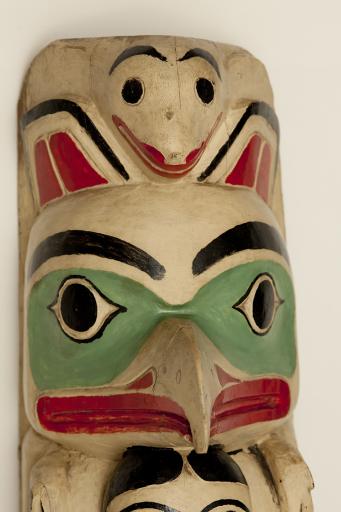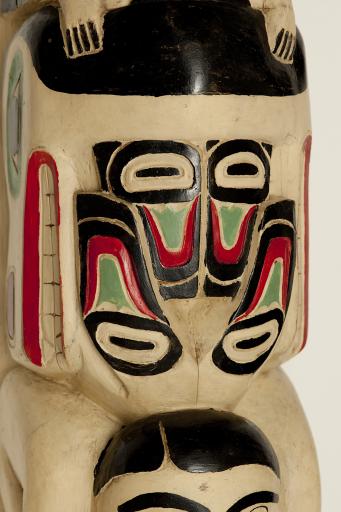totem pole, Luke Watson
Artwork Overview
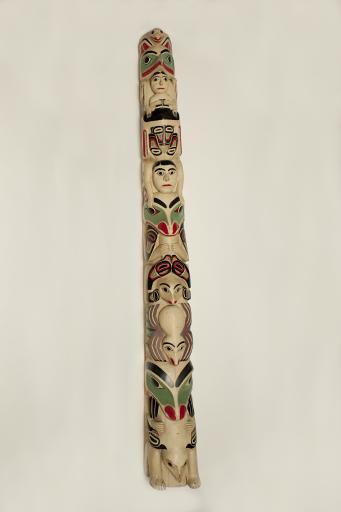
Object Height/Width/Depth (Height x Width x Depth): 261 x 30 x 28 cm
Object Height/Width/Depth (Height x Width x Depth): 102 3/4 x 11 13/16 x 11 in
If you wish to reproduce this image, please submit an image request
Images
Label texts
A sea otter, an eagle, whales, a giant crab, a magical halibut, and a raven come together in this totem pole to visually tell the story of two traditional Haida myths. The Haida people of the Pacific Northwest Coast rely on the power of oral history to transmit cultural knowledge. These brightly painted, carved wooden creatures would be immediately recognizable to the Haida as characters from well-known stories.
A sea otter, an eagle, whales, a giant crab, a magical halibut, and a raven come together in this totem pole to visually tell the story of two traditional Haida myths. The Haida people of the Pacific Northwest Coast rely on the power of oral history to transmit cultural knowledge. These brightly painted, carved wooden creatures would be immediately recognizable to the Haida as characters from well-known stories.
This totem pole comes from the Native American Haida (HI-duh) clan from the Pacific Northwest United States. It tells two stories through the people and animals shown on it. See if you can find each figure or animal as you read the descriptions below.
About the art
The top portion portrays the Nanasimgyet myth. In this story, a man named Nanasimgyet (fifth from the top of the totem) gives his wife (third from the top) a sea otter (top figure) to clean and skin. As she works at the water’s edge, she is captured and taken below the sea. With the help of an orca whale (sixth from the top of the totem), Nanasimgyet journeys underwater to free his wife and returns home with her.
The second legend is the Qagwaii, or “Strong Man,” tale. According to the Haida tradition, a young boy receives a magical halibut (a type of fish) skin that allows him to transform into this type of fish. While traveling in halibut form, the boy encounters many characters, including a giant crab (third from the bottom of the totem). Eventually, the boy has to return the halibut skin because his grandfather only let him borrow it.
About the animals
Sea otters are one of the only animals that use tools. They mainly use rocks to help them crack open the crabs that they eat.
Click the link below to see a photograph of a sea otter similar to this one.
This totem pole comes from the Native American Haida (HI-duh) clan from the Pacific Northwest United States. It tells two stories through the people and animals shown on it. See if you can find each figure or animal as you read the descriptions below.
About the art
The top portion portrays the Nanasimgyet myth. In this story, a man named Nanasimgyet (fifth from the top of the totem) gives his wife (third from the top) a sea otter (top figure) to clean and skin. As she works at the water’s edge, she is captured and taken below the sea. With the help of an orca whale (sixth from the top of the totem), Nanasimgyet journeys underwater to free his wife and returns home with her.
The second legend is the Qagwaii, or “Strong Man,” tale. According to the Haida tradition, a young boy receives a magical halibut (a type of fish) skin that allows him to transform into this type of fish. While traveling in halibut form, the boy encounters many characters, including a giant crab (third from the bottom of the totem). Eventually, the boy has to return the halibut skin because his grandfather only let him borrow it.
About the animals
Sea otters are one of the only animals that use tools. They mainly use rocks to help them crack open the crabs that they eat.
Tap the Web icon to see a sea otter similar to this one.
This is the end of our animal “tails”, but there are lots of other works of art in the Museum to observe! Try using some of the tricks you learned in this tour to look at another artwork. You can also use this app when you get home to look back at all the animals you encountered today.
Click on the audio tab above to listen to a student's interpretation of this object.
The Haida of the Pacific Northwest Coast never developed a written language, relying instead on oral history to transmit cultural, historic, and personal knowledge. Their rich artistic traditions, which include carving, weaving, and basketmaking, also use form line symbols, like those seen on this totem pole, to encode messages. In fact, most Haida poles are carved for one of four general purposes: to record the ancestry of a specific family, document the history of a clan, illustrate Haida folklore, or memorialize a single individual. Read from the top down, this folklore pole depicts two traditional stories that provide insight into Haida morality, history, religion, and ecological understanding.
This totem pole relates two myths of the Haida, indigenous peoples of the Pacific Northwest Coast. The top group of figures tell the tale of Nanasimgit (represented fifth from the top), the hero gives his wife (third from top) a sea otter (top figure) to clean and skin. As she works at the water’s edge, she is captured and taken to the undersea realm of killer whales (represented below both Nanasimgit and his wife). Nanasimgit’s love for his wife is so great that he faces many dangers to restore her to life.
The second legend is the Qagwaai or “Strong Man” tale. According to oral tradition, a young boy receives a magical halibut skin that allows him to transform into a halibut. While traveling in halibut form, the boy encounters many real life and mythological characters carved on the pole, including a giant crab (third from bottom). In several versions of this story, Qagwaai is dispatched to Naden Harbor on the northern shores of Haida Gwaii (Graham Island, British Columbia) to kill a monster crab that guards the inlet. Armed with his magical skin, the boy tears the giant crab into pieces that scatter throughout the shores; today, the Haida believe these pieces became the smaller crabs that continue to provide sustenance. According to the story, once the boy returns to his home, he is forced to return the skin, because it was only a loan from his grandfather.
Displayed both indoors and outdoors, totem poles are a ubiquitous fixture in traditional Haida villages. Most poles are carved for one of four general purposes: to record the ancestry of a specific family; document the history of a clan; illustrate Haida folklore; or memorialize a single individual. ‘Read’ from the top down, this folklore pole depicts two Haida traditional stories.
The top portion portrays the Nanasimgyet or “Orpheus” myth. In this tale, Nanasimgyet (represented fifth from the top) gives his wife (third from top) a sea otter (top figure) to clean and skin. As she works at the water’s edge, she is captured and taken below the sea. With the help of a whale (sixth from top), Nanasimgyet journeys underwater. He frees his wife and returns with her to the mainland.
The second legend is the Qagwaii or “Strong Man” tale. According to oral tradition, a young boy receives a magical halibut skin that allows him to transform into a halibut. While traveling in halibut form, the boy encounters many characters, including a giant crab (third from bottom). Eventually, the boy is forced to return the skin, as it was only a loan from his grandfather.
Displayed both indoors and outdoors, totem poles are a ubiquitous fixture in traditional Haida villages. Most poles are carved for one of four general purposes: to record the ancestry of a specific family; document the history of a clan; illustrate Haida folklore; or memorialize a single individual. ‘Read’ from the top down, this folklore pole depicts two Haida traditional stories.
The top portion portrays the Nanasimgyet or “Orpheus” myth. In this tale, Nanasimgyet (represented fifth from the top) gives his wife (third from top) a sea otter (top figure) to clean and skin. As she works at the water’s edge, she is captured and taken below the sea. With the help of a whale (sixth from top), Nanasimgyet journeys underwater. He frees his wife and returns with her to the mainland.
The second legend is the Qagwaii or “Strong Man” tale. According to oral tradition, a young boy receives a magical halibut skin that allows him to transform into a halibut. While traveling in halibut form, the boy encounters many characters, including a giant crab (third from bottom). Eventually, the boy is forced to return the skin, as it was only a loan from his grandfather.
Exhibition Label:
"Roots and Journeys: Encountering Global Arts and Cultures," Jul-2011, Nancy Mahaney
Displayed both indoors and outdoors, totem poles are a ubiquitous fixture in traditional Haida villages. Most poles are carved for one of four general purposes: to record the ancestry of a specific family; document the history of a clan; illustrate Haida folklore; or memorialize a single individual. ‘Read’ from the top down, this folklore pole depicts two Haida traditional stories.
The top portion portrays the Nanasimgyet or “Orpheus” myth. In this tale, Nanasimgyet (represented fifth from the top) gives his wife (third from top) a sea otter (top figure) to clean and skin. As she works at the water’s edge, she is captured and taken below the sea. With the help of a whale (sixth from top), Nanasimgyet journeys underwater. He frees his wife and returns with her to the mainland.
The second legend is the Qagwaii or “Strong Man” tale. According to oral tradition, a young boy receives a magical halibut skin that allows him to transform into a halibut. While traveling in halibut form, the boy encounters many characters, including a giant crab (third from bottom). Eventually, the boy is forced to return the skin, as it was only a loan from his grandfather.
Exhibitions
Cassandra Mesick, curator
Celka Straughn, curator
Kate Meyer, curator
Celka Straughn, curator
Cassandra Mesick, curator
Celka Straughn, curator
Kate Meyer, curator
Celka Straughn, curator
Celka Straughn, curator
Kristina Walker, curator
Angela Watts, curator
Celka Straughn, curator
Kristina Walker, curator
Angela Watts, curator
